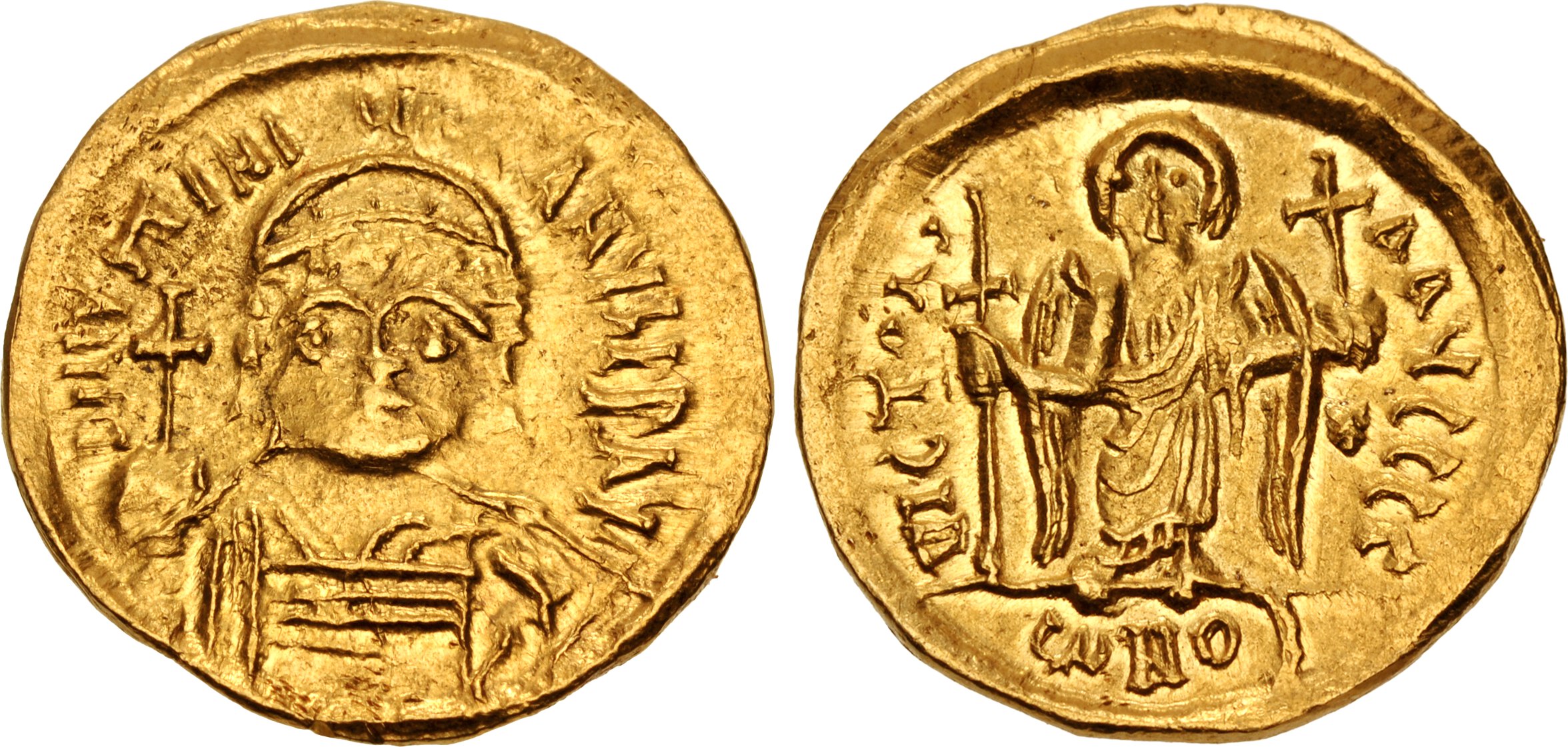S 113 - Carthage (Justinian), gold, solidi (527-565 CE)
From SILVER
527 CE - 565 CE Gold 115,315 kg
Description
| ObverseInscription or printing placed on the obverse.: | DNIVSTINI ANVSPPAVI (Latin).Helmeted and cuirassed facing bust, holding globus cruciger and shield |
| ReverseInscription or printing placed on the reverse.: | VICTORI AAVCCC CONOB (Latin).Angel standing facing, holding long cross and globus cruciger, star in right field, Γ (date)//CONOB |
Mint and issuing power
| MintIdentifies the place of manufacture or issue of a numismatic object.: | Carthage | Ancient regionAncient region.: | Zeugitana | Modern countryModern country: Tunisia | AuthorityIdentifies the issuing power. The authority can be "pretended" when the name or the portrait of X is on the coin but he/she was not the issuing power. It can also be "uncertain" when there is no mention of X on the coin but he/she was the issuing power according to the historical sources: | Justinian I (Byzantine emperor, 527-565 AD), Byzantine empire |
Chronology
| FromIdentifies the initial date in a range assigned in a numismatic context. | 527 CE | toIdentifies the final date in a range assigned in a numismatic context.. | 565 CE | PeriodTime period of the numismatic object.: Byzantine Empire |
Physical description
| MetalThe physical material (usually metal) from which an object is made.: | Gold |
Median weightMedian of the weights of numismatic objects (in grams). in grams | 4.40 | DenominationTerm indicating the value of a numismatic object. Examples: tetradrachm, chalkous, denarius.: | solidus | StandardStandard.: |
Image

S113 Carthage Justinian.jpg [1]
References
| Die study referencePublication of the study: | Morrisson 19881Morrisson 1988 | ||
| Coin series referenceReference to coin series study: | DOC 277c2DOC 277c, MIBE 2543MIBE 254 | ||
Obverse dies distribution
no distribution is available
Reverse dies distribution
no distribution is available
Quantification
| Number of obversesNumber of obverse dies. ᵖ (o) | 58 | Number of singletons (o1)The number of singleton coins. ᵖ | |
| Number of reverse diesNumber of reverse dies. (r) | 68 | Number of coinsNumber of coins. (n) | 90 |
| Coins per obverse dieNumber of coins per obverse die. (n/o) | 1.55 | Coins per reverse dieNumber of coins per reverse die. (n/r) | 1.32 |
| Reverse per obverse ratioRatio of obverse dies divided by reverse dies. (r/o) | 1.17 | Percentage of singletons (o1)number of coins (n) divided by the number of singletons (o1) ᵖ | % |
| Original number of dies (O) (Carter 1983 formula)The estimation of the number of coins according to Carter 1983 ᵖ | 131.04 | Coins struck if 20,000 as average productivity per dieCoins made if the average productivity for obverses (according to Carter) is 20,000. ᵖ | 2,620,800 |
| Original number of dies (O) (Esty 2011 formula)The estimation of the number of coins according to the singleton formula in Esty 2011 ᵖ (O) | 163.13 | Survival rate if 20,000 as average productivity per dieSurvival rate if average productivity is 20,000. ᵖ | 0.00003 |
| Coverage (o = % of O) (Esty 1984 formula)Esty 1984 - coverage (% of O) ᵖ (o = % of O) | % | Die productivity if survival rate 1/2,000Average productivity if survival rate is 1/2,000. ᵖ | 1,373.63 |
| Weight of silver (in kg) if 20,000 coins per die (O = Carter formula)Carter 1983 * Median weight * 20000 (*10 if gold or electrum) ᵖ | 115,315 kg <br /> 115,315 kg | Die productivity if survival rate 1/5,000Average productivity if survival rate is 1/5,000. ᵖ | 3,434.07 |
Remarks